A Study on the Spatial and Temporal Variation of Summer Surface Temperature in the Bosten Lake Basin and Its Influencing Factors
Abstract
:1. Introduction
2. Materials and Methods
2.1. Study Area
2.2. Data Sources
2.3. Research Methodology
2.3.1. MODIS Data Processing
2.3.2. Land Surface Temperature Class Classification
2.3.3. Trend Analysis Method
2.3.4. Hurst Index
2.3.5. Geo-Detector Model
3. Results
3.1. Spatial Distribution Characteristics of Land Surface Temperature
3.2. Characteristics of Interannual Variation of Surface Temperature
3.3. Characteristics of Land Surface Temperature Change Trends
3.4. Characteristics of Land Surface Temperature Change Trends
3.5. Analysis of the Drivers of the Spatial and Temporal Distribution of Surface Temperature
3.5.1. Factor Detection Analysis
3.5.2. Interaction Detection Analysis
3.5.3. Risk Detection Analysis among Impact Factors
4. Discussion
4.1. LST Spatiotemporal Distribution and Its Changing Trend
4.2. Analysis of LST Influence Factors
4.3. Research Limitations and Future Work
5. Conclusions
Author Contributions
Funding
Data Availability Statement
Conflicts of Interest
References
- Deng, Y.; Wang, S.; Bai, X.; Tian, Y.; Wu, L.; Xiao, J.; Chen, F.; Qian, Q. Relationship among Land Surface Temperature and LUCC, NDVI in Typical Karst Area. Sci. Rep. 2018, 8, 1–12. [Google Scholar] [CrossRef] [Green Version]
- Kikstra, J.S.; Nicholls, Z.R.; Smith, C.J.; Lewis, J.; Lamboll, R.D.; Byers, E.; Sandstad, M.; Meinshausen, M.; Gidden, M.J.; Rogelj, J.; et al. The IPCC Sixth Assessment Report WGIII Climate Assessment of Mitigation Pathways: From Emissions to Global Temperatures. Geosci. Model Dev. 2022, 15, 9075–9109. [Google Scholar] [CrossRef]
- Zheng, H.; Chen, Y.; Pan, W.; Cai, Y.; Chen, Z. Impact of Land Use/Land Cover Changes on the Thermal Environment in Urbanization: A Case Study of the Natural Wetlands Distribution Area in Minjiang River Estuary, China. Pol. J. Environ. Stud. 2019, 28, 3025–3041. [Google Scholar] [CrossRef]
- Liang, H.; Kasimu, A.; Ma, H.; Zhao, Y.; Zhang, X.; Wei, B. Exploring the Variations and Influencing Factors of Land Surface Temperature in the Urban Agglomeration on the Northern Slope of the Tianshan Mountains. Sustainability 2022, 14, 10663. [Google Scholar] [CrossRef]
- Ayanlade, A.; Aigbiremolen, M.I.; Oladosu, O.R. Variations in Urban Land Surface Temperature Intensity over Four Cities in Different Ecological Zones. Sci. Rep. 2021, 11, 20537. [Google Scholar] [CrossRef] [PubMed]
- Han, B.; Luo, Z.; Liu, Y.; Zhang, T.; Yang, L. Using Local Climate Zones to Investigate Spatio-Temporal Evolution of Thermal Environment at the Urban Regional Level: A Case Study in Xi’an, China. Sustain. Cities Soc. 2022, 76, 103495. [Google Scholar] [CrossRef]
- Peng, S.-S.; Piao, S.; Zeng, Z.; Ciais, P.; Zhou, L.; Li, L.Z.; Myneni, R.B.; Yin, Y.; Zeng, H. Afforestation in China Cools Local Land Surface Temperature. Proc. Natl. Acad. Sci. USA 2014, 111, 2915–2919. [Google Scholar] [CrossRef] [Green Version]
- Feldman, A.F.; Short Gianotti, D.J.; Dong, J.; Trigo, I.F.; Salvucci, G.D.; Entekhabi, D. Tropical Surface Temperature Response to Vegetation Cover Changes and the Role of Drylands. Glob. Chang. Biol. 2023, 29, 110–125. [Google Scholar] [CrossRef]
- Solangi, G.S.; Siyal, A.A.; Siyal, P. Spatiotemporal Dynamics of Land Surface Temperature and Its Impact on the Vegetation. Civ. Eng. J. 2019, 5, 1753–1763. [Google Scholar] [CrossRef]
- Peng, S.; Piao, S.; Ciais, P.; Friedlingstein, P.; Ottle, C.; Bréon, F.-M.; Nan, H.; Zhou, L.; Myneni, R.B. Surface Urban Heat Island across 419 Global Big Cities. Environ. Sci. Technol. 2012, 46, 696–703. [Google Scholar] [CrossRef]
- Juhua, L.; Jingcheng, Z.; Wenjiang, H.; Xingang, X.; Ning, J. Preliminary Study on the Relationship between Land Surface Temperature and Occurrence of Yellow Rust in Winter Wheat. Disaster Adv. 2010, 3, 288–292. [Google Scholar]
- Zhang, F.; Kung, H.; Johnson, V.C.; LaGrone, B.I.; Wang, J. Change Detection of Land Surface Temperature (LST) and Some Related Parameters Using Landsat Image: A Case Study of the Ebinur Lake Watershed, Xinjiang, China. Wetlands 2018, 38, 65–80. [Google Scholar] [CrossRef]
- Alimujiang, K.; Tang, B.; Gulikezi, T. Analysis of the Spatial-Temporal Dynamic Changes of Urban Expansion in Oasis of Xinjiang Based on RS and GIS. J. Glaciol. Geocryol 2013, 35, 1056–1064. [Google Scholar]
- Key, J.R.; Collins, J.B.; Fowler, C.; Stone, R.S. High-Latitude Surface Temperature Estimates from Thermal Satellite Data. Remote Sens. Environ. 1997, 61, 302–309. [Google Scholar] [CrossRef]
- Li, Z.; Duan, S.; Tang, B.; Wu, H.; Ren, H.; Yan, G.; Tang, R.; Leng, P. Review of Methods for Land Surface Temperature Derived from Thermal Infrared Remotely Sensed Data. J. Remote Sens. 2016, 20, 899–920. [Google Scholar]
- Yue, X.; Li, Z.; Li, H.; Wang, F.; Jin, S. Multi-Temporal Variations in Surface Albedo on Urumqi Glacier No. 1 in Tien Shan, under Arid and Semi-Arid Environment. Remote Sens. 2022, 14, 808. [Google Scholar] [CrossRef]
- Wang, B.; Ma, Y.; Ma, W. Estimation of Land Surface Temperature Retrieved from EOS/MODIS in Naqu Area over Tibetan Plateau. J. Remote Sens 2012, 16, 1289–1309. [Google Scholar]
- Jing, S.; Ping, Z.; Qi, Y. A Split-Window Algorithm for Retrieving Land Surface Temperature from ASTER Data. Remote Sens. Technol. Appl. 2012, 27, 728–734. [Google Scholar]
- Kustas, W.P.; Norman, J.M.; Anderson, M.C.; French, A.N. Estimating Subpixel Surface Temperatures and Energy Fluxes from the Vegetation Index–Radiometric Temperature Relationship. Remote Sens. Environ. 2003, 85, 429–440. [Google Scholar] [CrossRef]
- Xiong, Y.; Zhao, S.; Yin, J.; Li, C.; Qiu, G. Effects of Evapotranspiration on Regional Land Surface Temperature in an Arid Oasis Based on Thermal Remote Sensing. IEEE Geosci. Remote Sens. Lett. 2016, 13, 1885–1889. [Google Scholar] [CrossRef]
- Xiao, R.; Weng, Q.; Ouyang, Z.; Li, W.; Schienke, E.W.; Zhang, Z. Land Surface Temperature Variation and Major Factors in Beijing, China. Photogramm. Eng. Remote Sens. 2008, 74, 451–461. [Google Scholar] [CrossRef] [Green Version]
- Hou, H.; Liu, K.; Li, X.; Chen, S.; Wang, W.; Rong, K. Assessing the Urban Heat Island Variations and Its Influencing Mechanism in Metropolitan Areas of Pearl River Delta, South China. Phys. Chem. Earth Parts A/B/C 2020, 120, 102953. [Google Scholar] [CrossRef]
- Suo, N.; Yao, Y.; Zhang, B. Comparative Study on the Mountain Elevation Effect of the Tibetan Plateau and the Alps. Geogr. Res 2020, 39, 2568–2580. [Google Scholar]
- Chen, H.; Liu, L.; Zhang, Z.; Liu, Y.; Tian, H.; Kang, Z.; Wang, T.; Zhang, X. Spatio-Temporal Correlation between Human Activity Intensity and Land Surface Temperature on the North Slope of Tianshan Mountains. J. Geogr. Sci. 2022, 32, 1935–1955. [Google Scholar] [CrossRef]
- Ahmed, G.; Zan, M.; Kasimu, A. Spatial–Temporal Changes and Influencing Factors of Surface Temperature in Urumqi City Based on Multi-Source Data. Environ. Eng. Sci. 2022, 39, 928–937. [Google Scholar] [CrossRef]
- Maimaitiyiming, M.; Ghulam, A.; Tiyip, T.; Pla, F.; Latorre-Carmona, P.; Halik, Ü.; Sawut, M.; Caetano, M. Effects of Green Space Spatial Pattern on Land Surface Temperature: Implications for Sustainable Urban Planning and Climate Change Adaptation. ISPRS J. Photogramm. Remote Sens. 2014, 89, 59–66. [Google Scholar] [CrossRef] [Green Version]
- Jiang, J.; Tian, G. Analysis of the Impact of Land Use/Land Cover Change on Land Surface Temperature with Remote Sensing. Procedia Environ. Sci. 2010, 2, 571–575. [Google Scholar] [CrossRef] [Green Version]
- Taniguchi, M.; Shimada, J.; Tanaka, T.; Kayane, I.; Sakura, Y.; Shimano, Y.; Dapaah-Siakwan, S.; Kawashima, S. Disturbances of Temperature-Depth Profiles Due to Surface Climate Change and Subsurface Water Flow: 1. An Effect of Linear Increase in Surface Temperature Caused by Global Warming and Urbanization in the Tokyo Metropolitan Area, Japan. Water Resour. Res. 1999, 35, 1507–1517. [Google Scholar] [CrossRef]
- Wu, Z.; Huang, N.E.; Wallace, J.M.; Smoliak, B.V.; Chen, X. On the Time-Varying Trend in Global-Mean Surface Temperature. Clim. Dyn. 2011, 37, 759–773. [Google Scholar] [CrossRef] [Green Version]
- Chao, Z.; Wang, L.; Che, M.; Hou, S. Effects of Different Urbanization Levels on Land Surface Temperature Change: Taking Tokyo and Shanghai for Example. Remote Sens. 2020, 12, 2022. [Google Scholar] [CrossRef]
- Wang, H.; Pan, Y.; Chen, Y. Impacts of Regional Climate and Teleconnection on Hydrological Change in the Bosten Lake Basin, Arid Region of Northwestern China. J. Water Clim. Chang. 2018, 9, 74–88. [Google Scholar] [CrossRef]
- Zhao, W.; Duan, S.-B. Reconstruction of Daytime Land Surface Temperatures under Cloud-Covered Conditions Using Integrated MODIS/Terra Land Products and MSG Geostationary Satellite Data. Remote Sens. Environ. 2020, 247, 111931. [Google Scholar] [CrossRef]
- Wang, Y.; Yao, Y.; Chen, S.; Ni, Z.; Xia, B. Spatiotemporal Evolution of Urban Development and Surface Urban Heat Island in Guangdong-Hong Kong-Macau Greater Bay Area of China from 2013 to 2019. Resour. Conserv. Recycl. 2022, 179, 106063. [Google Scholar] [CrossRef]
- Yu, H.; Bian, Z.; Mu, S.; Yuan, J.; Chen, F. Effects of Climate Change on Land Cover Change and Vegetation Dynamics in Xinjiang, China. Int. J. Environ. Res. Public Health 2020, 17, 4865. [Google Scholar] [CrossRef]
- Hamed, K.H. Trend Detection in Hydrologic Data: The Mann–Kendall Trend Test under the Scaling Hypothesis. J. Hydrol. 2008, 349, 350–363. [Google Scholar] [CrossRef]
- Jiang, T.-H.; Deng, L.-T. Some Problems in Estimating a Hurst Exponent-a Case Study of Applicatings to Climatic Change. Sci. Geogr. Sin. 2004, 24, 177–182. [Google Scholar]
- Wang, J.; Xu, C. Geodetector: Principle and Prospective. Acta Geogr. Sin. 2017, 72, 116–134. [Google Scholar]
- Masson-Delmotte, V.; Zhai, P.; Pörtner, H.-O.; Roberts, D.; Skea, J.; Shukla, P.R.; Pirani, A.; Moufouma-Okia, W.; Péan, C.; Pidcock, R.; et al. Global Warming of 1.5 C. IPCC Spec. Rep. Impacts Glob. Warm. 2018, 1, 43–50. [Google Scholar]
- Yu, H.; Zhang, H.; Yang, Y. An Analysis of Extremely Hot Weather Process on Turpan Basin. Clim. Chang. Res. Lett. 2013, 2, 109–113. [Google Scholar] [CrossRef]
- Lin, W.; Wang, G.; Zhang, S.; Zhao, Z.; Xing, L.; Gan, H.; Tan, X. Heat Aggregation Mechanisms of Hot Dry Rocks Resources in the Gonghe Basin, Northeastern Tibetan Plateau. Acta Geol. Sin.-Engl. Ed. 2021, 95, 1793–1804. [Google Scholar] [CrossRef]
- Sun, R.; Chen, A.; Chen, L.; Lü, Y. Cooling Effects of Wetlands in an Urban Region: The Case of Beijing. Ecol. Indic. 2012, 20, 57–64. [Google Scholar] [CrossRef]
- Li, Z.; Liu, X.; Ma, T.; Kejia, D.; Zhou, Q.; Yao, B.; Niu, T. Retrieval of the Surface Evapotranspiration Patterns in the Alpine Grassland–Wetland Ecosystem Applying SEBAL Model in the Source Region of the Yellow River, China. Ecol. Model. 2013, 270, 64–75. [Google Scholar] [CrossRef]
- Tranvik, L.J.; Downing, J.A.; Cotner, J.B.; Loiselle, S.A.; Striegl, R.G.; Ballatore, T.J.; Dillon, P.; Finlay, K.; Fortino, K.; Knoll, L.B.; et al. Lakes and Reservoirs as Regulators of Carbon Cycling and Climate. Limnol. Oceanogr. 2009, 54, 2298–2314. [Google Scholar] [CrossRef] [Green Version]
- Shimoda, Y.; Azim, M.E.; Perhar, G.; Ramin, M.; Kenney, M.A.; Sadraddini, S.; Gudimov, A.; Arhonditsis, G.B. Our Current Understanding of Lake Ecosystem Response to Climate Change: What Have We Really Learned from the North Temperate Deep Lakes? J. Great Lakes Res. 2011, 37, 173–193. [Google Scholar] [CrossRef]
- Hoegh-Guldberg, O.; Jacob, D.; Bindi, M.; Brown, S.; Camilloni, I.; Diedhiou, A.; Djalante, R.; Ebi, K.; Engelbrecht, F.; Guiot, J.; et al. Impacts of 1.5 C Global Warming on Natural and Human Systems. Glob. Warm. 1.5 °C 2018. [Google Scholar]
- Li, X.; Zhang, F.; Chan, N.W.; Shi, J.; Liu, C.; Chen, D. High Precision Extraction of Surface Water from Complex Terrain in Bosten Lake Basin Based on Water Index and Slope Mask Data. Water 2022, 14, 2809. [Google Scholar] [CrossRef]
- Peng, X.; Wu, W.; Zheng, Y.; Sun, J.; Hu, T.; Wang, P. Correlation Analysis of Land Surface Temperature and Topographic Elements in Hangzhou, China. Sci. Rep. 2020, 10, 10451. [Google Scholar] [CrossRef]
- Özhancı, E.; Koç, A. The Effect of Different Area Uses and Topography on Surface Temperature and Climate Parameters. Environ. Sci. Pollut. Res. 2023, 30, 47038–47051. [Google Scholar] [CrossRef]
- Xu, H.; Li, T.-B.; Chen, J.-N.; Liu, C.-N.; Zhou, X.; Xia, L. Characteristics and Applications of Ecological Soil Substrate for Rocky Slope Vegetation in Cold and High-Altitude Areas. Sci. Total Environ. 2017, 609, 446–455. [Google Scholar] [CrossRef]
- Marston, R.A.; Anderson, J.E. Watersheds and Vegetation of the Greater Yellowstone Ecosystem. Conserv. Biol. 1991, 5, 338–346. [Google Scholar] [CrossRef]
- Marzban, F.; Sodoudi, S.; Preusker, R. The Influence of Land-Cover Type on the Relationship between NDVI–LST and LST-T Air. Int. J. Remote Sens. 2018, 39, 1377–1398. [Google Scholar] [CrossRef]
- Lu, X.-Y.; Chen, X.; Zhao, X.-L.; Lv, D.-J.; Zhang, Y. Assessing the Impact of Land Surface Temperature on Urban Net Primary Productivity Increment Based on Geographically Weighted Regression Model. Sci. Rep. 2021, 11, 22282. [Google Scholar] [CrossRef]
- Mao, D.; Luo, L.; Wang, Z.; Zhang, C.; Ren, C. Variations in Net Primary Productivity and Its Relationships with Warming Climate in the Permafrost Zone of the Tibetan Plateau. J. Geogr. Sci. 2015, 25, 967–977. [Google Scholar] [CrossRef] [Green Version]
- Wang, Y.; Zhang, S.; Chang, X. Evapotranspiration Estimation Based on Remote Sensing and the SEBAL Model in the Bosten Lake Basin of China. Sustainability 2020, 12, 7293. [Google Scholar] [CrossRef]
- Peng, J.; Xie, P.; Liu, Y.; Ma, J. Urban Thermal Environment Dynamics and Associated Landscape Pattern Factors: A Case Study in the Beijing Metropolitan Region. Remote Sens. Environ. 2016, 173, 145–155. [Google Scholar] [CrossRef]
- Grömping, U. Variable Importance Assessment in Regression: Linear Regression versus Random Forest. Am. Stat. 2009, 63, 308–319. [Google Scholar] [CrossRef]
- Brunsdon, C.; Fotheringham, S.; Charlton, M. Geographically Weighted Regression. J. R. Stat. Soc. Ser. D (Stat.) 1998, 47, 431–443. [Google Scholar] [CrossRef]
- Kondratyev, K.Y.; Varotsos, C. Atmospheric Greenhouse Effect in the Context of Global Climate Change. Il Nuovo Cim. C 1995, 18, 123–151. [Google Scholar] [CrossRef]
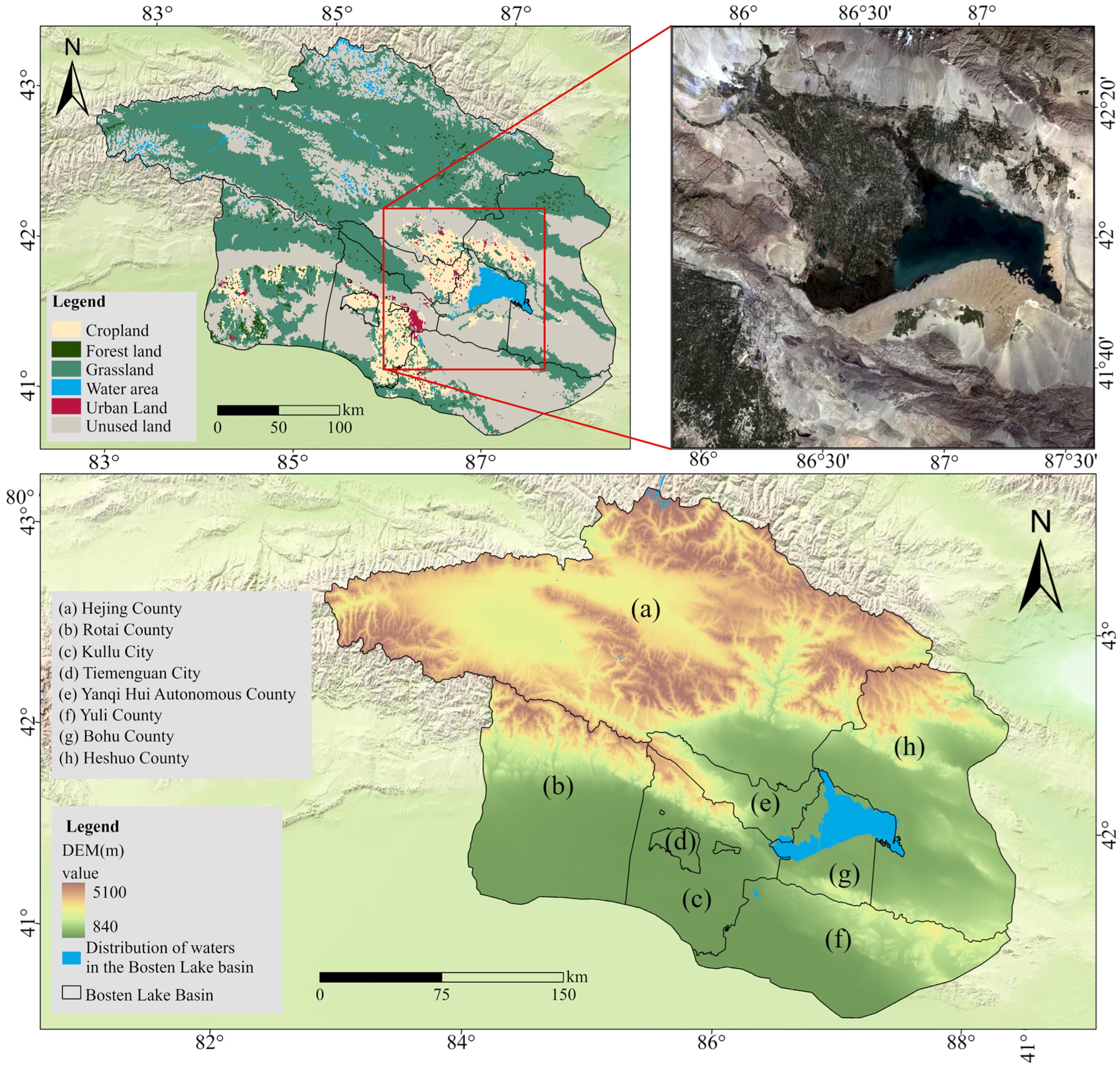



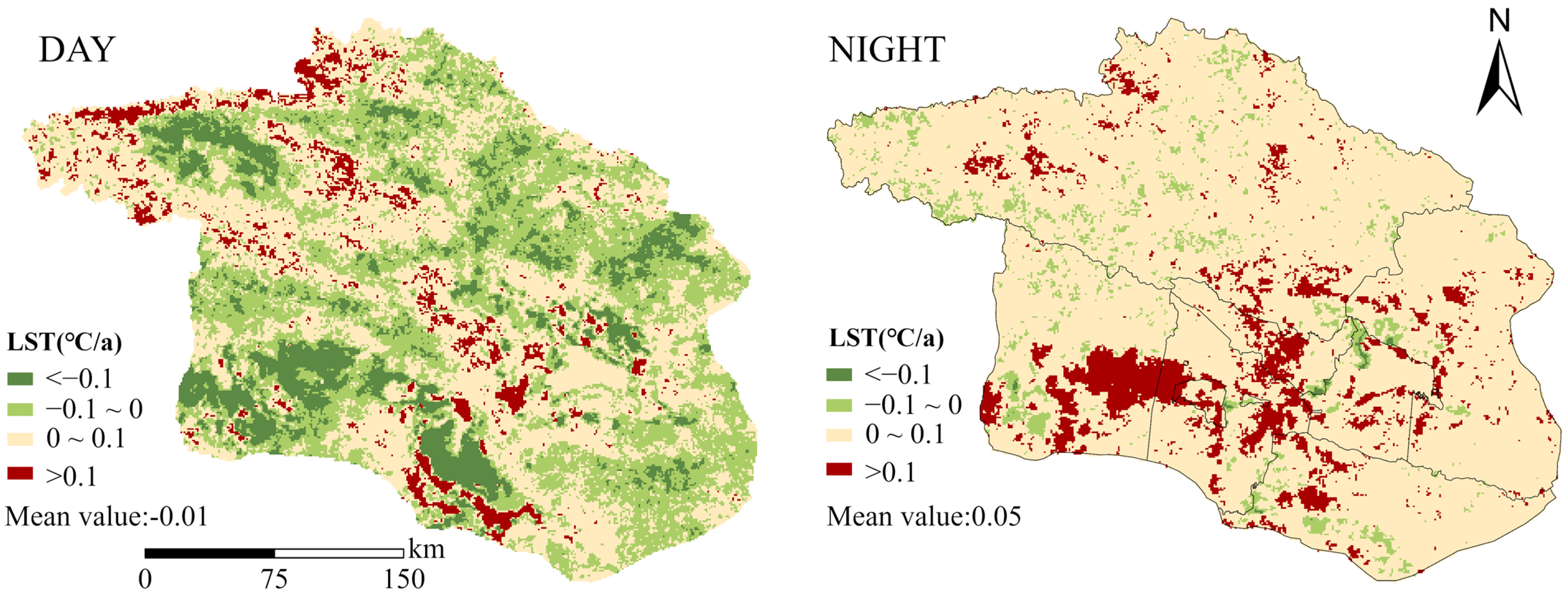

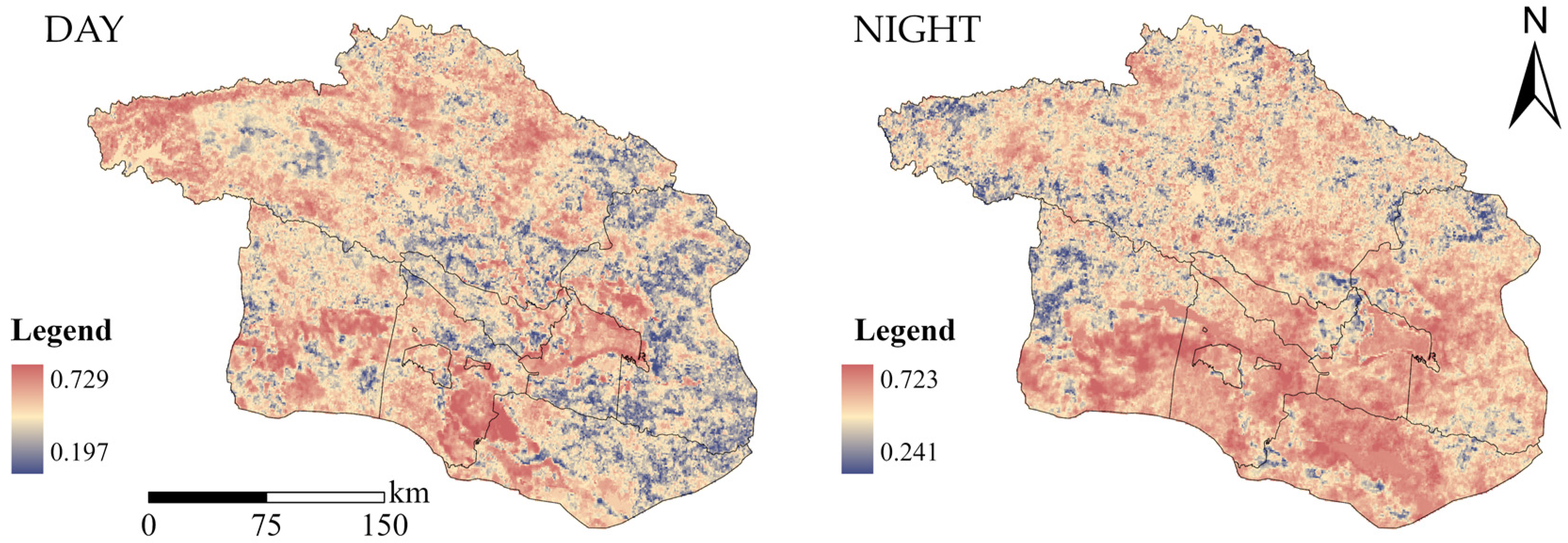

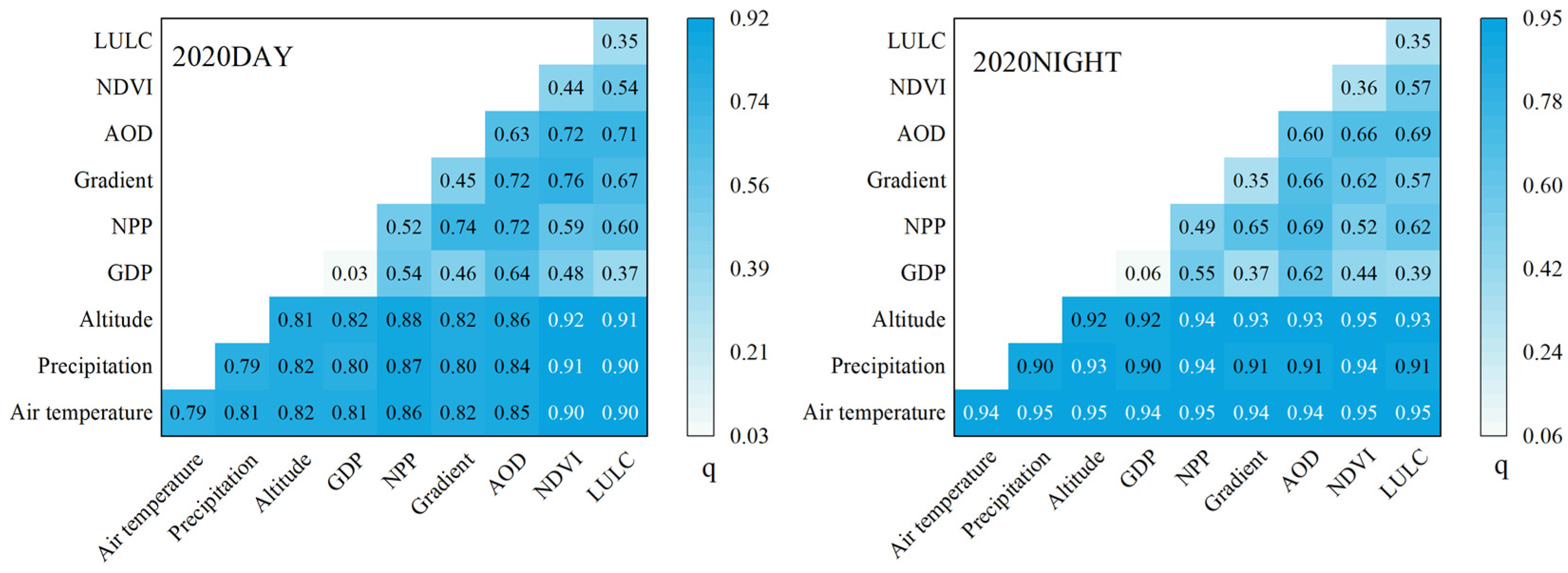
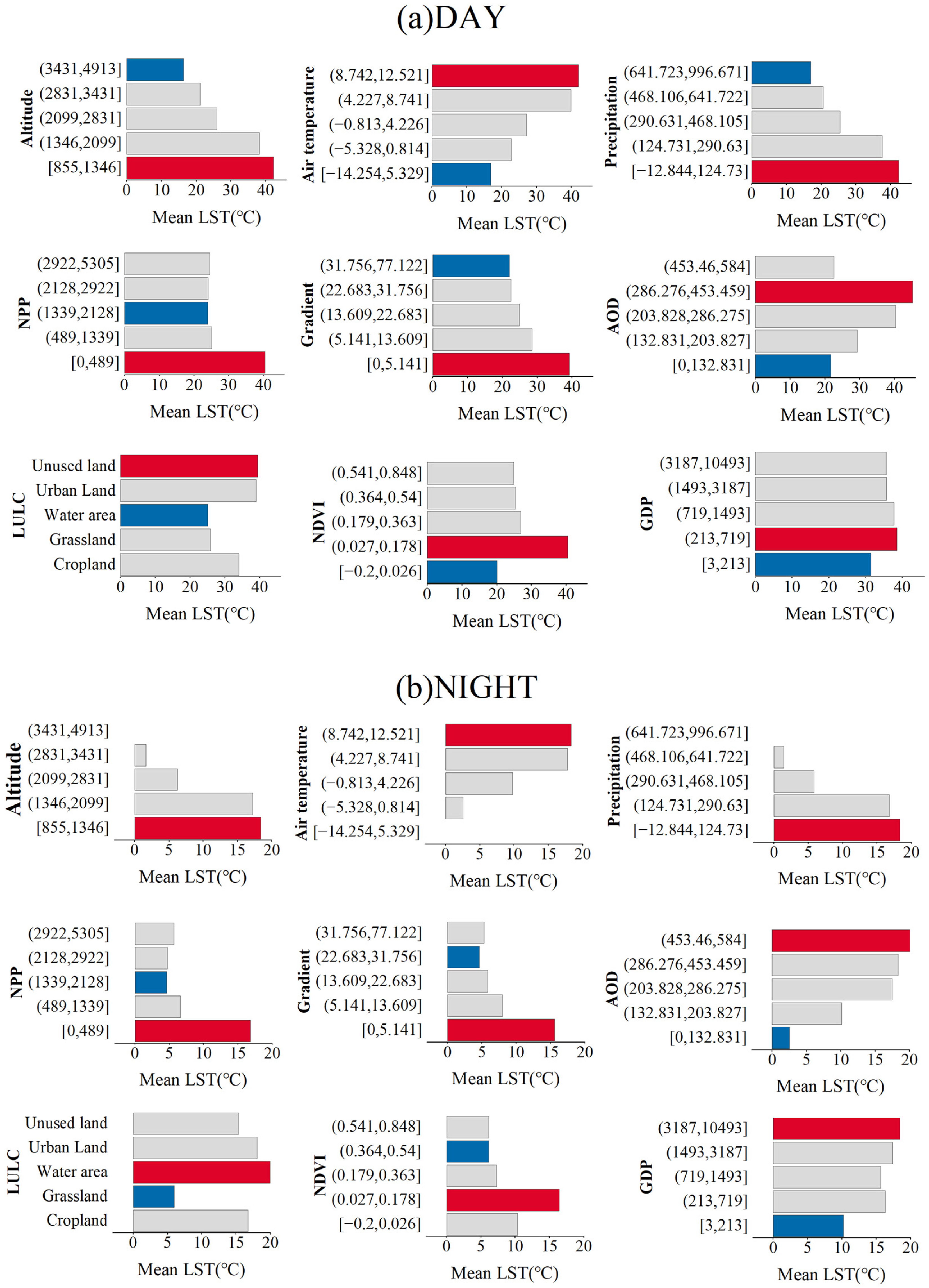
| Types of Influencing Factors | Influencing Factors | Spatial Resolution | Year | Access |
|---|---|---|---|---|
| Ground cover factors | Normalized difference vegetation index (NDVI) | 1000 m | 2020 | https://www.nasa.gov/ (accessed on 10 September 2022) |
| Land-use/land-cover (LULC) | 30 m | 2020 | https://www.resdc.cn/ (accessed on 10 September 2022) | |
| Net primary production (NPP) | 500 m | 2020 | ||
| Climate factors | Precipitation | 1000 m | 2020 | |
| Air temperature | 1000 m | 2020 | ||
| Aerosol optical depth (AOD) | 1000 m | 2020 | ||
| Socio-economic factors | Gross domestic product (GDP) | 1000 m | 2020 | |
| Terrain factors | DEM | 30 m | - | http://www.gscloud.cn (accessed on 10 September 2022) |
| Gradient | 30 m | 2020 | ||
| Altitude | 30 m | 2020 |
| Surface Temperature Class | Classification Range |
|---|---|
| Extremely high temperature (EHT) | |
| High temperature (HT) | |
| Medium temperature (MT) | |
| Low temperature (LT) | |
| Extremely low temperature (ELT) |
| Trend of Change | Statistical Quantity Z |
|---|---|
| Extremely significant reduction | Z ≤ −2.58 |
| Significant reduction | −2.58 < Z ≤ −1.96 |
| No significant change | −1.96 < Z ≤ 1.96 |
| Significant increase | 1.96 ≤ Z < 2.58 |
| Extremely significant increase | Z > 2.58 |
| Slope, Z-Value, and Hurst Index | Future Trends of Change |
|---|---|
| Slope < 0, Z ≤ −2.58, Hurst > 0.5 | Continued highly significant reduction (Chsr) |
| Slope < 0, −2.58 < Z ≤ −1.96, Hurst > 0.5 | Continued significant reduction (Csr) |
| Slope < 0, −1.96 < Z < 1.96, Hurst > 0.5 | Sustained non-significant decrease (Snsd) |
| Slope > 0, 1.96 < Z < 1.96, Hurst > 0.5 | Sustained non-significant elevation (Snse) |
| Slope > 0, 1.96 ≤ Z < 2.58, Hurst > 0.5 | Continued significant elevation (Cse) |
| Slope > 0, Z ≥ 2.58, Hurst > 0.5 | Continued highly significant elevation (Chse) |
| Hurst ≤ 0.5 | No significant change (Nsc) |
| Time | q-Value | ||||||||
|---|---|---|---|---|---|---|---|---|---|
| Air Temperature | Precipitation | Altitude | GDP | NPP | Gradient | AOD | NDVI | LULC | |
| 2020 day | 0.793 * | 0.787 * | 0.806 * | 0.034 | 0.519 * | 0.450 * | 0.631 * | 0.445 * | 0.345 * |
| 2020 night | 0.936 * | 0.897 * | 0.917 * | 0.062 * | 0.487 * | 0.346 * | 0.603 * | 0.357 * | 0.354 * |
Disclaimer/Publisher’s Note: The statements, opinions and data contained in all publications are solely those of the individual author(s) and contributor(s) and not of MDPI and/or the editor(s). MDPI and/or the editor(s) disclaim responsibility for any injury to people or property resulting from any ideas, methods, instructions or products referred to in the content. |
© 2023 by the authors. Licensee MDPI, Basel, Switzerland. This article is an open access article distributed under the terms and conditions of the Creative Commons Attribution (CC BY) license (https://creativecommons.org/licenses/by/4.0/).
Share and Cite
Jumai, M.; Kasimu, A.; Liang, H.; Tang, L.; Aizizi, Y.; Zhang, X. A Study on the Spatial and Temporal Variation of Summer Surface Temperature in the Bosten Lake Basin and Its Influencing Factors. Land 2023, 12, 1185. https://doi.org/10.3390/land12061185
Jumai M, Kasimu A, Liang H, Tang L, Aizizi Y, Zhang X. A Study on the Spatial and Temporal Variation of Summer Surface Temperature in the Bosten Lake Basin and Its Influencing Factors. Land. 2023; 12(6):1185. https://doi.org/10.3390/land12061185
Chicago/Turabian StyleJumai, Miyesier, Alimujiang Kasimu, Hongwu Liang, Lina Tang, Yimuranzi Aizizi, and Xueling Zhang. 2023. "A Study on the Spatial and Temporal Variation of Summer Surface Temperature in the Bosten Lake Basin and Its Influencing Factors" Land 12, no. 6: 1185. https://doi.org/10.3390/land12061185







